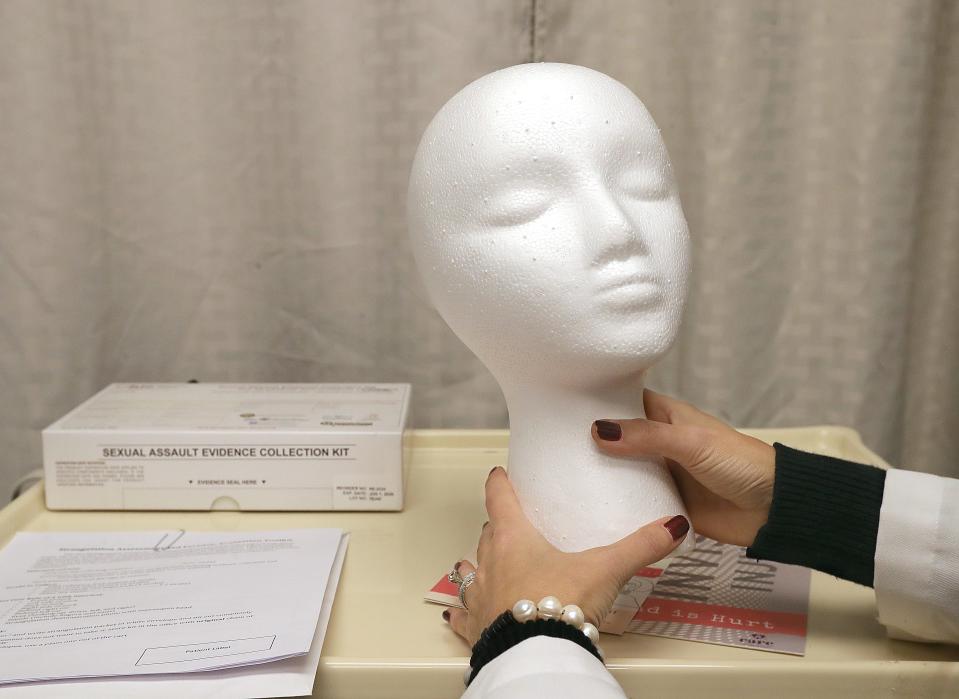Ohio strengthens strangulation charge, becoming last state to make it a felony

As her estranged husband held her against the wall, squeezing her neck with both hands, a Barberton, Ohio woman kept thinking, “I have to get free.”
“I just wanted desperately to breathe,” the 46-year-old woman recalled.
She tried to grab his head and face. He finally let go, and she gasped for air. As soon as she could scream, she yelled for her roommate to call 911.
Police took her estranged husband into custody, and he was one of the first people to be charged under a new Ohio law that took effect last April that made strangulation a felony.
Counties all over the state and nation have reported rising strangulation cases and deaths, with Franklin County recording 605 strangulation cases in 2023.
Ohio was the last state to make strangulation a felony. Previously, strangulation could only be filed as a misdemeanor domestic violence charge.
Victim advocates and forensic nurses are triumphant after lobbying for years to toughen charges related to strangulation, which typically involve domestic violence and too often are followed by murders.
The new law comes with stiffer penalties than misdemeanor charges previously did.
Depending on the severity of harm and the relationship between the person charged and the victim, strangulation can be a second- to fifth-degree felony. A second-degree felony carries a penalty of up to eight years in prison, while a fifth-degree felony can result in up to 12 months in prison but doesn’t require incarceration.
The man who held his wife against a wall, making it difficult for her to breathe before finally letting her go, was charged in May in Summit County — located in Northeast Ohio and with Akron as its county seat — with domestic violence and strangulation. He isn't being named to protect her identity for safety reasons.
Despite the new law, he took a plea deal and got two years of probation.
“Strangulation is not OK,” said Rachel Ramirez, the director of health and disability programs for ODVN. “Strangulation is not something we’re willing to tolerate. If you do it, there will be consequences.”
What is strangulation, according to the new law?
Ohio’s strangulation law prohibits a person from causing serious harm or creating a “substantial risk” of harm through strangulation or suffocation.
It defines strangulation or suffocation as impeding “the normal breathing or circulation of the blood by applying pressure to the throat or neck or by covering the nose and mouth.”
Strangulation injuries can linger long after visible bruises have faded, leaving victims at risk of a stroke and mental health issues like post-traumatic stress disorder and, in severe cases, traumatic brain injuries.
Twenty-two percent of the people killed by their partners in Ohio between June 2022 and July 2023 died from strangulation or traumatic brain injuries, according to the Ohio Domestic Violence Network (ODVN).
Implementation of Ohio’s new law in Columbus, Franklin County
In April, the month the law went into effect, Franklin County officials reported an average of two strangulation cases per day.
Franklin County saw 605 total strangulation cases in 2023, and there were 78 in the first month of 2024.
The Franklin County Municipal Court filed 683 strangulation-related charges using the new law in 2023 and the first month of 2024.
Ramirez pointed to Columbus as one of the cities that has been the most proactive in responding to the law. The city used an $800,000 federal grant to create a multi-agency strangulation task force and to train officers about strangulation.
Columbus took this step after seeing a 200% increase in homicides involving domestic violence in 2023.
Victim advocates say some communities aren't charging people as much under the new law as Franklin County has.
“There have been some great success stories and frustrations,” Ramirez said. “Law enforcement has a lot on their hands. I do think we need to give them a little bit of time and grace.”
More: Columbus domestic violence homicides up 200% in 2023. How one family is finding hope
What is the process for women after they are strangled?
When strangulation victims are examined, hospital staff take photographs of their injuries, swab for DNA, get details about the incident and have them demonstrate how they were strangled with a mannequin.
Lily Holderbaum, a forensic nurse and the head of the PATH, or Providing Access to Healing, program at Cleveland Clinic Akron General, said strangulation is dangerous because it involves “intentional deadly force.”
“That patient could have died within minutes,” she said.
Holderbaum said strangulation victims are at risk of a blood clot or stroke that might not happen until a week or month later.
She also said victims of strangulation aren’t always seen in the emergency department and may end up seeking treatment in another department, such as physical or occupational therapy. The hospital plans to offer training on strangulation in March to departments outside of the ER.
“There isn’t enough of a discussion of the injuries that can happen with strangulation,” she said.
Strangulation law ‘reflects the seriousness of the crime,’ prosecutor says
Elliot Kolkovich, the community outreach prosecutor for the Summit County Prosecutor’s office, said strangulations often happen in volatile domestic situations that could also involve multiple forms of injury, such as punching, slapping and throwing a person onto the ground or against something.
Prior to the strangulation law, Kolkovich said a person could have been charged under the domestic violence, assault or felonious assault statutes, depending on how seriously the victim was injured. He said strangulation victims, though, might not immediately have visible injuries beyond something like petechiae, or ruptured blood vessels, in the eyes.
Now that strangulation is at least a fifth-degree felony, Kolkovich said, it has stiffer penalties than domestic violence, which is a first-degree misdemeanor for a first offense with a minor injury.
“It reflects the seriousness of the crime,” Kolkovich said. “Some of the domestic violence incidents involve hitting and punching. When you have a strangulation, you could be close to taking a person’s life.”
The sentences are up to the judges who consider a variety of factors, including the potential for the person to reoffend, the severity of the victim’s injuries, and whether the defendant accepted responsibility, Kolkovich said.
Though few strangulations cases have gone to trial so far across Ohio, a Canton man was sentenced to four years in prison in December after being convicted in a jury trial of choking, punching and slapping a woman.
Stark County Common Pleas Judge Natalie Haupt said she thought prison time was warranted.
“I think this case demonstrates the very reason that strangulation is now a felony in Ohio,” Haupt said.

Columbus Dispatch Reporter Bethany Bruner contributed to this story. Stephanie Warsmith can be reached at swarsmith@thebeaconjournal.com, 330-996-3705 and on Twitter: @swarsamithabj.
dking@dispatch.com
@DanaeKing
This article originally appeared on Akron Beacon Journal: Ohio strengthens penalties for strangulation charge

